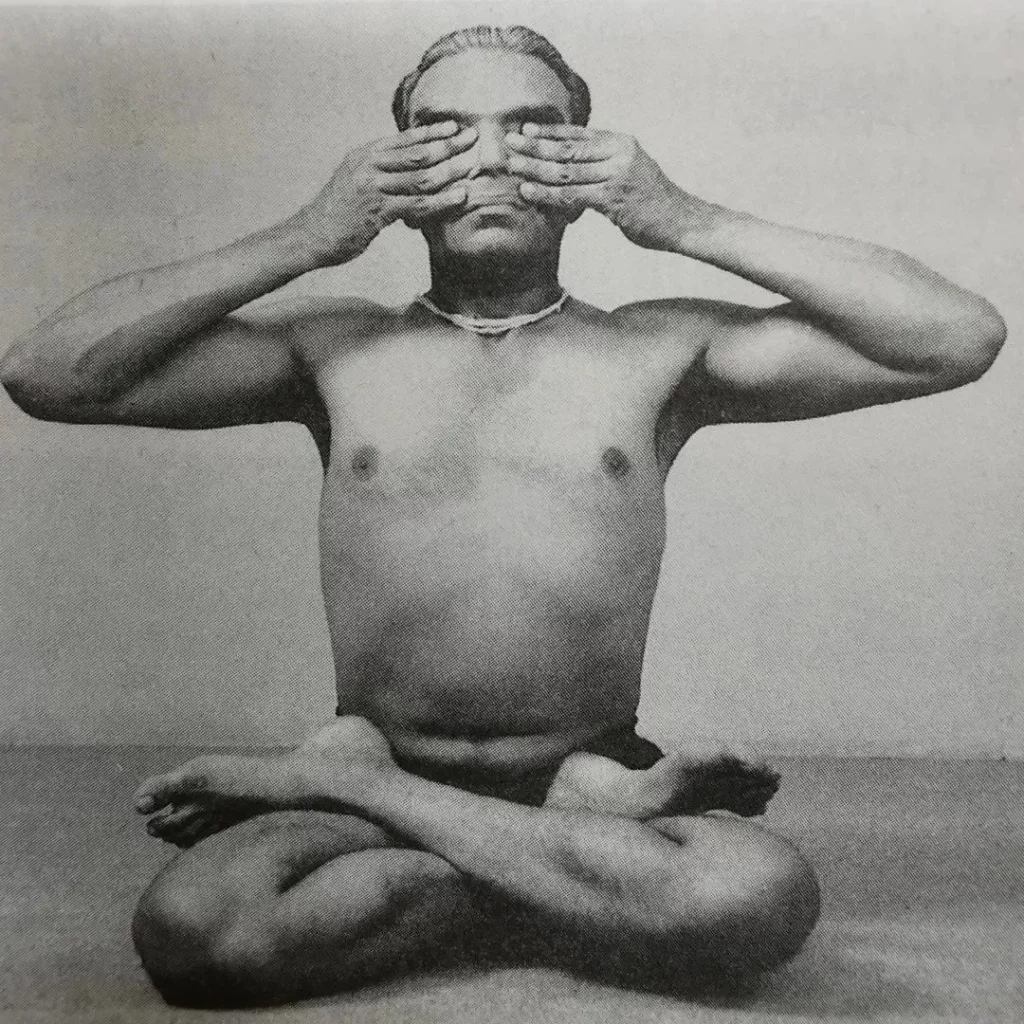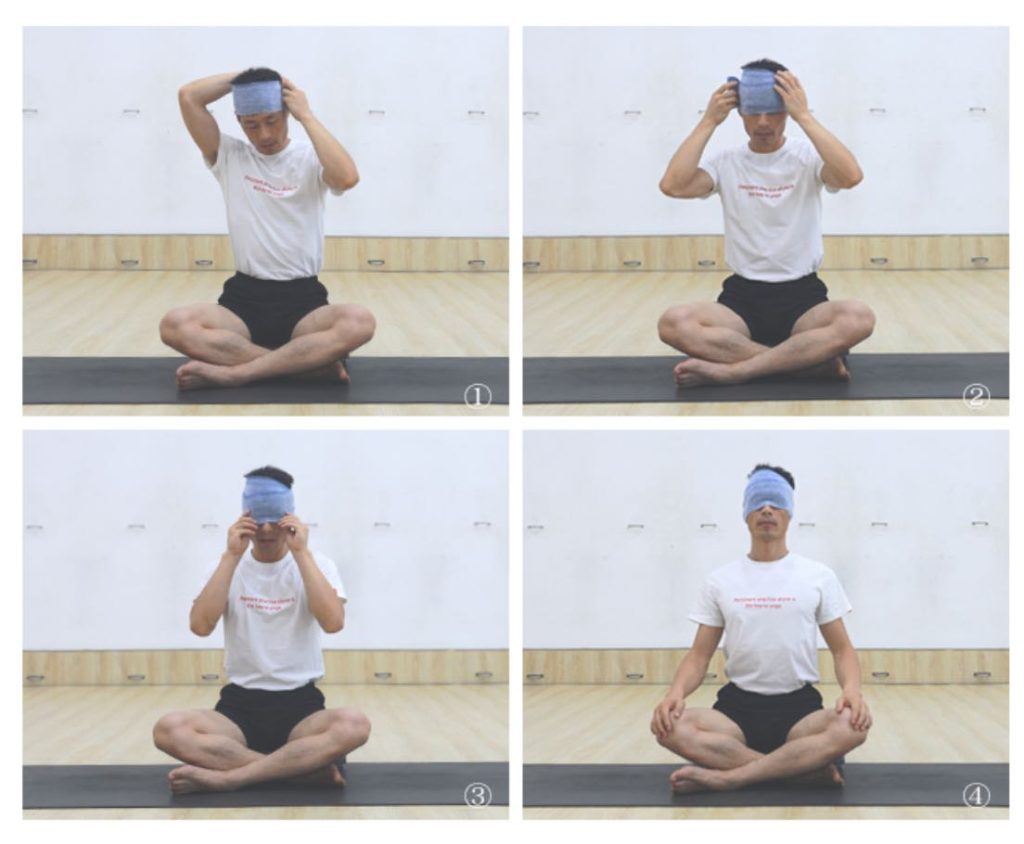
All the lectures of the great Indian philosopher Krishnamurti are based on a concept of “alert passivity.” He often spoke about it, saying that reaching this state is extremely challenging and requires heightened sensitivity. Master Iyengar once experienced this state during the Shanmukhi Mudra (Six-headed Warrior Pose), but it was quite difficult to maintain the position of arms and fingers in this pose for an extended time. Thus, Master Iyengar used a band for the first time.

On another day, Master Iyengar said to Krishnamurti, “Sir, you often say that achieving alert passivity is difficult. But simply by using a strap, this alert passivity appears immediately. How simple it is!”
Since then, Master Iyengar began applying this technique to people with high blood pressure, glaucoma, retinal detachment, and other eye problems, allowing their eyes to relax. Once the eyes relax, the nerves relax, and the mind calms down. This method is also used during supported headstands (Sālamba Śīrṣāsana) to avoid pressure on the eyes, preventing eye redness or broken capillaries. This is the reason for using the strap.
How to Use the Strap and Shanmukhi Mudra (Six-headed Warrior Pose)

In yoga, we have postures (āsana), gestures (mudrā), and locks (bandha). Their purpose is to block, control, elevate, and direct vital energy to where it’s needed. The use of straps can be considered a type of bandha known as Patta Bandha (strap lock). There are three ways to use it: wrapping the forehead as Śīropatta Bandha (forehead strap lock), wrapping the eyes as Netrapatta Bandha (eye strap lock), and wrapping both the forehead and eyes as Śīronetra Patta Bandha (forehead and eye strap lock).
This way of wrapping with the strap serves the same function as Shanmukhi Mudra. I saw that students could not hold the Shanmukhi Mudra for even five minutes, so I found this method to help them achieve the benefits of this gesture. The purpose of Shanmukhi Mudra is to withdraw the senses from the outer world and turn inward.
Our eyes, ears, and other sensory organs are closer to the brain and mind. Any disturbance to the eyes and ears distracts the brain and mind. If the eyes are the windows to the brain, then the ears are the windows to the mind or consciousness. When the brain is active, the eyes immediately protrude. The same happens during sleep; if there are fluctuations in the brain, the eyes react.

Sound can disturb the mind and strain the brain. Even a gentle vibration affects the ears faster than electronic instruments, impacting both the brain and mind. Although the ears may not show physical movement, you can feel them become alert. The eyes also respond instantly, becoming tense and rigid.
In Shanmukhi Mudra, we place fingers and palms on the eyes, ears, nostrils, and upper lip in a specific way to keep the brain passive and the mind alert, turning inward to feel the presence of the soul.
Master Iyengar said he liked to use Shanmukhi Mudra with every student, either in Savasana (Corpse Pose) or in seated postures. Even now, many people see me using this method in class, applying gentle pressure with a strap to relax the muscles and nerves at the base of the brain. When the eyes and ears withdraw inward, the sensory vibrations, brain activity, and mind disturbances calm down, reaching a state of stillness. Wrapping the eyes quickly suppresses fluctuations, making the brain passive and the mind alert, allowing us to experience both mental stillness (manolaya) and controlled consciousness (citta nirodha).
This method can help students understand the qualities of mental stillness. After experiencing the calmness of the brain and mind, I encourage them to learn to replicate this tranquility without using the strap.

Benefits for People with Emotional Issues, Mental Stress, High Blood Pressure, or Eye and Ear Problems
Therapeutic Value of the Strap
For those with high blood pressure, the strap can be wrapped around the eyes during certain postures to normalize blood pressure, including supported headstand (Sālamba Śīrṣāsana), supported shoulder stand (Sālamba Sarvāṅgāsana), Halasana (Plow Pose), Setu Bandha Sarvāṅgāsana (Bridge Pose Shoulder Stand), and Viparita Karani (Inverted Pose).
For cases of headaches, burning eyes, glaucoma, and retinal detachment, using the strap is not only beneficial but should be a routine practice for prevention and treatment. In cases of high blood pressure, glaucoma, or retinal detachment, wrap the area around the eyebrows or the base of the brain (Śīro patta bandha). This allows the eyelids to naturally relax downward without the help of fingers. For people with eye infections or severe issues, cover the eyes with a folded strap.
If the brain is agitated, tense, or under excessive pressure, or if a person is irritable, dizzy, has blurred vision, or burning eyes, the strap should be used in all postures. In Savasana (Corpse Pose), both the eyes and forehead should be covered (Śīronetra patta bandha). When feeling lazy, lethargic, or depressed, keep the eyes open while practicing.
Master Iyengar said, “Props help you gain understanding and sensitivity. Undoubtedly, props are good; they allow you to hold postures longer. When you stay longer in a pose, you should treat it as a power station, constantly enhancing the sensitivity of your intellect within the body. In this sense, props are great friends and blessings.
However, if you rely on them entirely just to rest in a posture, they will make you dull and lazy. Then they become a curse.
Yoga is meant to achieve freedom. But by doing this, you are not free; instead, you are bound. The same props can grant you freedom or bind you, depending on how and why you use them.”